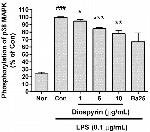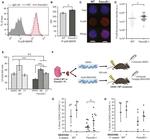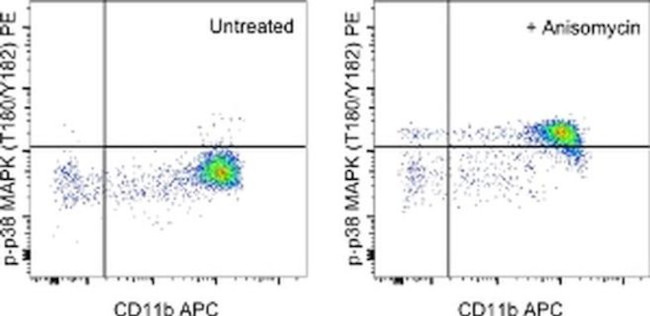Invitrogen
Phospho-p38 MAPK (Thr180, Tyr182) Monoclonal Antibody (4NIT4KK), PE, eBioscience™
FIGURE: 1 / 3
Phospho-p38 MAPK (Thr180, Tyr182) Antibody (12-9078-42) in Flow



Product Details
12-9078-42
Species Reactivity
Published species
Host/Isotype
Recommended Isotype Control
Class
Type
Clone
Conjugate
Excitation/Emission Max
Form
Concentration
Purification
Storage buffer
Contains
Storage conditions
Shipping conditions
RRID
Product Specific Information
Description: This 4NIT4KK monoclonal antibody recognizes human and mouse p38 mitogen-activated protein kinase (MAPK) when phosphorylated on T180/Y182. p38 MAPK belongs to a family of conserved serine/threonine protein kinases that are phosphorylated and activated in response to numerous stress stimuli including TLR ligands (such as LPS), osmotic shock, heat shock, UV irradiation, and inflammatory cytokines. There are four p38 MAPK members that include p38 alpha, p38 beta, p38 gamma, and p38 delta. The primary activators of p38 MAPK are MKK3/4 and MKK6. Several downstream targets of p38 MAPK have been identified including MK2/3, p53, ATF-2, and ETS1. p38 MAPK can be negatively regulated by the chemical inhibitor SB203580. Specificity of this 4NIT4KK clone was determined by ELISA, flow cytometry, and western blotting.
Applications Reported: This 4NIT4KK antibody has been reported for use in intracellular staining followed by flow cytometric analysis.
Applications Tested: This 4NIT4KK antibody has been pre-titrated and tested by intracellular staining followed by flow cytometric analysis of normal human peripheral blood cells. This can be used at 5 µL (0.06 µg) per test. A test is defined as the amount (µg) of antibody that will stain a cell sample in a final volume of 100 µL. Cell number should be determined empirically but can range from 10^5 to 10^8 cells/test.
Staining Protocol: All protocols work well for this monoclonal antibody. Use of Protocol A: Two-step protocol: intracellular (cytoplasmic) proteins allows for the greatest flexibility for detection of surface and intracellular (cytoplasmic) proteins. Use of Protocol B: One-step protocol: intracellular (nuclear) proteins is recommended for staining of transcription factors in conjunction with surface and phosphorylated intracellular (cytoplasmic) proteins. Protocol C: Two-step protocol: Fixation/Methanol allows for the greatest discrimination of phospho-specific signaling between unstimulated and stimulated samples, but with limitations on the ability to stain specific surface proteins (refer to "Clone Performance Following Fixation/Permeabilization" located in the Best Protocols Section under the Resources tab online). All Protocols can be found in the Flow Cytometry Protocols: "Staining Intracellular Antigens for Flow Cytometry Protocol" located in the Best Protocols Section under the Resources tab online.
Excitation: 488-561 nm; Emission: 578 nm; Laser: Blue Laser, Green Laser, Yellow-Green Laser.
Filtration: 0.2 µm post-manufacturing filtered.
Target Information
The p38 MAPK cascade regulates a variety of cellular responses to stress, inflammation, and other signals. p38 MAPK is relatively inactive in the nonphosphorylated form and becomes rapidly activated by dual phosphorylation of a Thr-Gly-Tyr motifs. There are four isoforms of p38 MAPK, which differ in their tissue expression and affinity for upstream activators and downstream effectors. When cells are exposed to tumor necrosis factor, interleukin-1, heat shock, or other activating stimuli, activation of MAPK kinase-3 occurs by phosphorylation. Activated MAPK kinase-3/6 phosphorylate each residue of Thr180 and Tyr182 in p38 MAPK. Phospho-p38 MAPK activates ATF-2, CHOP-1, MEF-2 and other transcription factors through phosphorylation.
For Research Use Only. Not for use in diagnostic procedures. Not for resale without express authorization.
How to use the Panel Builder
Watch the video to learn how to use the Invitrogen Flow Cytometry Panel Builder to build your next flow cytometry panel in 5 easy steps.
Bioinformatics
Protein Aliases: CRK1; CSAID-binding protein; Csaids binding protein; cytokine suppressive anti-inflammatory drug binding protein; cytokine suppressive anti-inflammatory drug binding protein 1; Cytokine suppressive anti-inflammatory drug-binding protein; MAP kinase 14; MAP kinase MXI2; MAP kinase p38 alpha; MAPK 14; MAX-interacting protein 2; mitogen activated protein kinase 14; Mitogen-activated protein kinase 14; Mitogen-activated protein kinase p38 alpha; p38 alpha; p38 MAP kinase; p38 MAP kinase alpha; p38 MAPK; p38 mitogen activated protein kinase; p38alpha Exip; SAPK2a; Stress-activated protein kinase 2a; tRNA synthetase cofactor p38
Gene Aliases: Crk1; CSBP; CSBP1; CSBP2; CSPB1; EXIP; MAPK14; MXI2; p38; p38-alpha; p38a; p38ALPHA; p38MAPK; PRKM14; PRKM15; RK; SAPK2A
UniProt ID: (Human) Q16539, (Mouse) P47811
Entrez Gene ID: (Human) 1432, (Mouse) 26416

Performance Guarantee
If an Invitrogen™ antibody doesn't perform as described on our website or datasheet,we'll replace the product at no cost to you, or provide you with a credit for a future purchase.*
Learn more
We're here to help
Get expert recommendations for common problems or connect directly with an on staff expert for technical assistance related to applications, equipment and general product use.
Contact tech support

